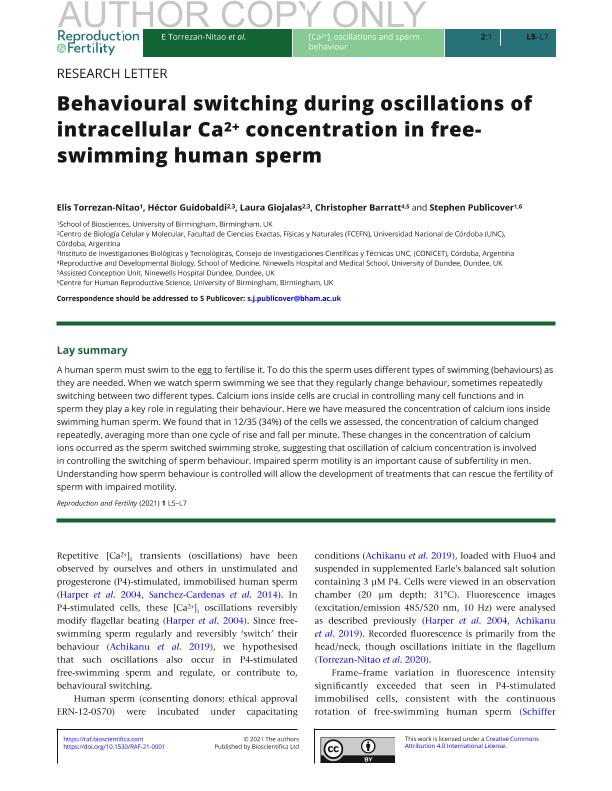Artículo
Behavioural switching during oscillations of intracellular Ca2+ concentration in free-swimming human sperm
Torrezan Nitao, Elis; Guidobaldi, Héctor Alejandro ; Giojalas, Laura Cecilia
; Giojalas, Laura Cecilia ; Barratt, Christopher; Publicover, Stephen
; Barratt, Christopher; Publicover, Stephen
 ; Giojalas, Laura Cecilia
; Giojalas, Laura Cecilia ; Barratt, Christopher; Publicover, Stephen
; Barratt, Christopher; Publicover, Stephen
Fecha de publicación:
09/03/2021
Editorial:
BioScientifica
Revista:
Reproduction and Fertility
e-ISSN:
2633-8386
Idioma:
Inglés
Tipo de recurso:
Artículo publicado
Clasificación temática:
Resumen
A human sperm must swim to the egg to fertilise it. To do this the sperm uses different types of swimming (behaviours) as they are needed. When we watch sperm swimming we see that they regularly change behaviour, sometimes repeatedly switching between two different types. Calcium ions inside cells are crucial in controlling many cell functions and in sperm they play a key role in regulating their behaviour. Here we have measured the concentration of calcium ions inside swimming human sperm. We found that in 12/35 (34%) of the cells we assessed, the concentration of calcium changed repeatedly, averaging more than one cycle of rise and fall per minute. These changes in the concentration of calcium ions occurred as the sperm switched swimming stroke, suggesting that oscillation of calcium concentration is involved in controlling the switching of sperm behaviour. Impaired sperm motility is an important cause of subfertility in men. Understanding how sperm behaviour is controlled will allow the development of treatments that can rescue the fertility of sperm with impaired motility.
Palabras clave:
SPERM
,
HUMAN
,
CALCIUM
,
HYPERACTIVATION
Archivos asociados
Licencia
Identificadores
Colecciones
Articulos(IIBYT)
Articulos de INSTITUTO DE INVESTIGACIONES BIOLOGICAS Y TECNOLOGICAS
Articulos de INSTITUTO DE INVESTIGACIONES BIOLOGICAS Y TECNOLOGICAS
Citación
Torrezan Nitao, Elis; Guidobaldi, Héctor Alejandro; Giojalas, Laura Cecilia; Barratt, Christopher; Publicover, Stephen; Behavioural switching during oscillations of intracellular Ca2+ concentration in free-swimming human sperm; BioScientifica; Reproduction and Fertility; 2; 1; 9-3-2021; 5-7
Compartir
Altmétricas



